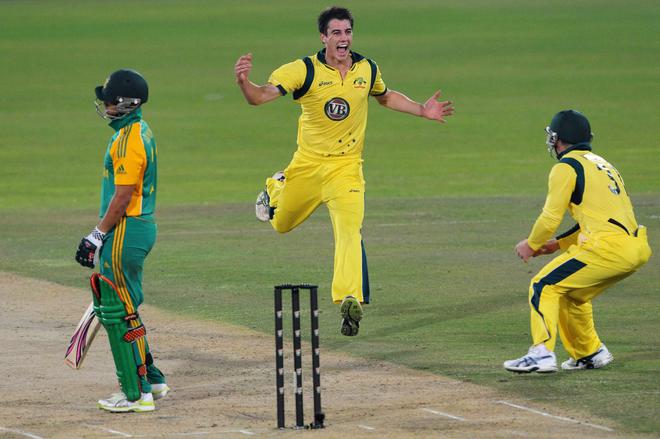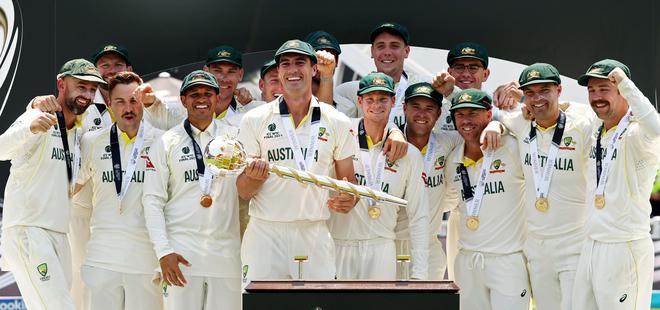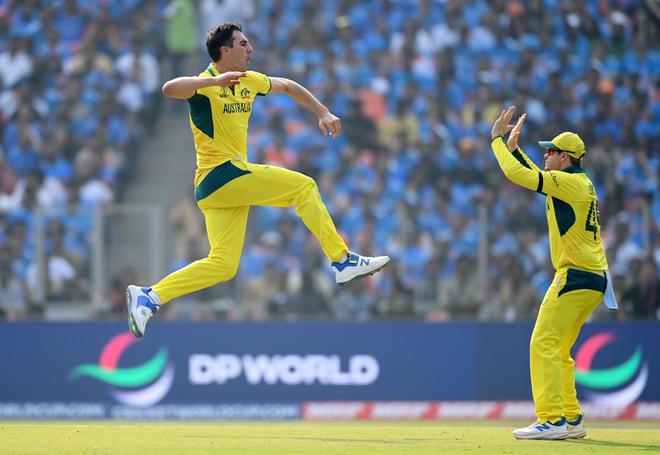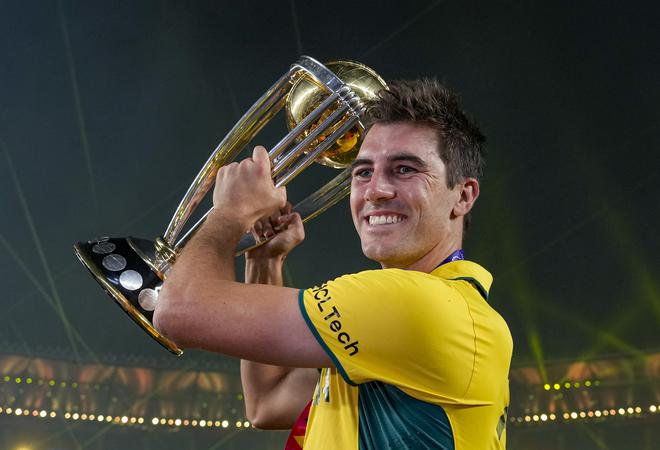Pat Cummins wears a broad smile as he stands awkwardly on the makeshift stage, the ODI World Cup trophy held low in his hands. He looks to one side and waits for his teammates to join him in the celebration. The Australian cricket team had only just ripped the script of India’s fairytale campaign and its captain was politely waiting for the dignitaries to leave the platform before the team could rush in and together lift Australia’s sixth World Cup trophy.
Rewind to 2006, when an Australian side at the peak of its powers won a first Champions Trophy that had long eluded them. At the presentation ceremony after the final, Ricky Ponting, the chief architect of that golden generation, beckons the BCCI president to hand over the trophy and the rest of the team pushes the official off the stage, to spark the revelry... and a barrage of criticism in the following days.
Much ink has been spilt on the softening of the Australian cricket team in recent years, well documented in The Test web series, but these two moments 17 years apart probably sum it best. The bravado of one captain gave way to the niceness of the modern, post-Sandpapergate skipper.
It is said that captaining the Test team is the second-most important job Down Under, only behind that of the Prime Minister. Yet, Cummins is almost apologetic about the machismo innate to Australians when he describes how his leadership style is different from previous captains.
“I think it’s different to what’s been done in sport, especially in Australia,” he tells YouTube channel Business of Sport. “You know Australia has quite a macho kind of culture, whereas nowadays you have guys coming out of school, barely adults, trying to find their way through life. And our team spends 10 or 11 months on the road in a year. So if you don’t have a culture that is welcoming and fun, it becomes all-consuming.”
The job did look like it was consuming him in a packed schedule this year. Coming into the World Cup, Cummins was not in the best form and looked jaded in the first two games. But his teammates would later credit his calmness and tact to guide the team through choppy waters and cap off a nine-game winning streak to win the title.
Injuries and insults
The journey to the summit has been an arduous one for the blue-eyed boy from Sydney’s Blue Mountains. Having played cricket since he was five, he made his big break into the national team as a lanky, brittle 18-year-old. The new pace bowling sensation from the land of fast, bouncy wickets debuted in all three formats in the 2011 tour of South Africa. A Man of the Match award in his Test debut set tongues wagging, but what followed was misery. A string of injuries relegated him to playing only white-ball cricket over the next few years. He would play his next Test match only six years later, in 2017.

The recurring back stress fracture kept him out of action for extended periods, but he thrived even when the chips were down. With an education grant from the Australian Cricketers Association, Cummins completed a bachelor of business degree at the University of Technology, Sydney. “For four or five years there, until I was about 23, I spent more time injured than playing. I studied that whole time,” said Cummins, as quoted on the ACA website.
The comeback from there would be glorious. In 2017, Cummins made his way back into the Test team and this time, he stayed for good. By 2019, he became the first Australian since Glenn McGrath to be ranked World No. 1 in the Test bowling rankings and was subsequently named ICC’s Men’s Test Player of the Year. In the decade prior to his promotion to captaincy, Cummins would have the best bowling average of any Test player who bowled in over 20 innings. Picking 164 wickets in 34 Tests at an average of 21.59, he was truly on top of the world when the opportunity to take up the scandal-ridden top job landed on his lap in November 2021. Then, the critics came for him.
Too soft, too nice, the stereotypical dumb fast bowler, no captaining experience... the criticisms came thick and fast as his every move was scrutinised mercilessly. As the first fast bowler to be named Australia’s full-time captain, this was on expected lines. But he took it all in his stride and charmed the socks off the haters. Though his bowling figures took a slight hit, Captain Cummins prepared the team, and himself, for a crucial 2023 that will forever redeem him.
Bittersweet year
It would be a year of highs and lows for him. Starting with the Test tour of India, the Australian side under Cummins crumbled to concede defeats in the first two Tests. And if things weren’t going well for him professionally, he was dealt a bigger blow in his personal life. He left the team midway through the series to go home to his ailing mother, who would later pass away. Cummins missed the next two Tests, where the Aussies captained by once-disgraced skipper Steve Smith pulled off a big win and a draw to avoid a whitewash.
Questions are asked again if Australia still preferred the nice guy over the more tactical Smith. The latter refutes it. “My time is done. It’s Pat’s team now,” Smith told reporters.

To keep himself fresh for the crucial months of international cricket ahead of him, Cummins had already by then made the big decision to skip the 2023 Indian Premier League season. He also used the break to spend time with his toddler son. Kolkata Knight Riders fans were upset. In the previous edition, he showed them that he could wield the bat as well as he did the ball, scoring the joint-fastest 50 in IPL history.
But giving up the riches of franchise cricket would reap greater dividends at the World Test Championship final, the Ashes and the ODI World Cup. The Aussie quick in him perhaps needed the rest more than the captain in him.
Facing India in the World Test Championship final, Cummins proved to be the right figurehead for a team that was ending an excellent two-year Test cycle. As Travis Head and Scott Boland thrived, Cummins quietly led the side to a convincing 209-run victory that would land Australia its first World Test Championship title.
Then came the Ashes. Cummins was not his best self with the ball in the series. He picked up 18 wickets in 5 Tests at a meagre average of 37.7. He was also criticised for squandering a 2-0 lead in the series to draw it 2-2. Nevertheless, he played arguably the most crucial knock of the series, scoring the winning runs in the second Test. Australia just about managed to retain the Ashes on English shores, in the face of Brendon McCullum’s aggressive ‘Baz-ball’ influence. And Cummins was rightly credited for proving his mettle as a leader in the swinging conditions.
Into the World Cup
But did the good show in Tests warrant him captaining the ODI side on the big stage? After all, he had led the national side in the shorter format in only four games before, a point that was often emphasised ahead of the tournament. Moreover, Australia’s poor start did not help matters. The heavy losses to India and South Africa were bruising, and the pundits were calling for his head once again.
The third match against Sri Lanka changed everything — the turning point in the game, and the campaign, manoeuvred by the captain himself. The Sri Lankans were riding high at 125 for nought when Cummins dismissed the two openers. The two wickets were almost vindictive and the five-wicket win vindicative. Suddenly, Australia was off to the races.

Cummins ended the tournament with 15 wickets, most notably those of New Zealand’s golden boy Rachin Ravindra in the group stage, South Africa’s rampaging David Miller in the semifinals and the ultimate scalp of Virat Kohli in the final. All three instances involved the batsmen looking in good flow to bolster their team’s score, had it not been for Cummins’ intervention. He also played an important supporting role to Glenn Maxwell’s pyrotechnics against Afghanistan, scoring 12 just off 68 balls, but more importantly, providing stability as the immobile Maxwell went about crushing records.
During the tournament, Cummins would leave an indelible mark in other ways, too. He took time off the bustling World Cup schedule to spend several hours with students in a school in Aurangabad, Uttar Pradesh, in his capacity as a UNICEF Australia ambassador. Later, after the victorious summit clash, he is seen handing over the World Cup trophy to support staff and taking pictures of them.
Captain Fantastic
For all his exploits and likeability, Cummins stood tall as a leader when his team needed him most. He admits he was unsure of whether to field or bat right up to the coin toss in the final. But he rightly judged the wicket to be dry enough for him and his fellow bowlers to shine, so he sent India in to bat. He used his bowlers well to stop the in-form Indian lineup from building long partnerships.

His illustrious predecessor Ponting later heaped praise on Cummins for an “almost faultless” display of captaincy in the final to humble the nearly indestructible Indians.
“I thought his leadership actually has got better and better right through the tournament. His bowling has got better, and the way he used his bowlers today and some of his field placements, outstanding,” Ponting told Sky Sports.
A long-time admirer of Indian cricket crowds, Cummins ironically relished the stunned silence at the Narendra Modi stadium on the day. It was uncharacteristic of Indian cricket fans but the Aussies didn’t care. At the end of it all, Cummins stood victorious as the fireworks went off in the Ahmedabad sky.
The smiling assassin had finished the job.







